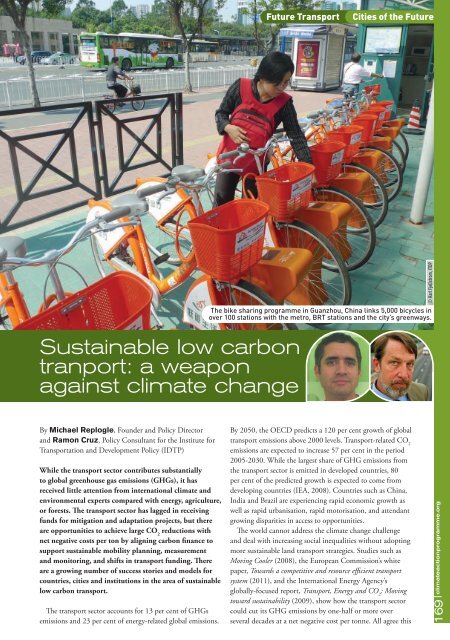Climate Action 2011-2012
You also want an ePaper? Increase the reach of your titles
YUMPU automatically turns print PDFs into web optimized ePapers that Google loves.
Future Transport<br />
Cities of the Future<br />
The bike sharing programme in Guanzhou, China links 5,000 bicycles in<br />
over 100 stations with the metro, BRT stations and the city’s greenways.<br />
© Karl Fjellstrom, ITDP<br />
Sustainable low carbon<br />
tranport: a weapon<br />
against climate change<br />
By Michael Replogle, Founder and Policy Director<br />
and Ramon Cruz, Policy Consultant for the Institute for<br />
Transportation and Development Policy (IDTP)<br />
While the transport sector contributes substantially<br />
to global greenhouse gas emissions (GHGs), it has<br />
received little attention from international climate and<br />
environmental experts compared with energy, agriculture,<br />
or forests. The transport sector has lagged in receiving<br />
funds for mitigation and adaptation projects, but there<br />
are opportunities to achieve large CO 2<br />
reductions with<br />
net negative costs per ton by aligning carbon finance to<br />
support sustainable mobility planning, measurement<br />
and monitoring, and shifts in transport funding. There<br />
are a growing number of success stories and models for<br />
countries, cities and institutions in the area of sustainable<br />
low carbon transport.<br />
The transport sector accounts for 13 per cent of GHGs<br />
emissions and 23 per cent of energy-related global emissions.<br />
By 2050, the OECD predicts a 120 per cent growth of global<br />
transport emissions above 2000 levels. Transport-related CO 2<br />
emissions are expected to increase 57 per cent in the period<br />
2005-2030. While the largest share of GHG emissions from<br />
the transport sector is emitted in developed countries, 80<br />
per cent of the predicted growth is expected to come from<br />
developing countries (IEA, 2008). Countries such as China,<br />
India and Brazil are experiencing rapid economic growth as<br />
well as rapid urbanisation, rapid motorisation, and attendant<br />
growing disparities in access to opportunities.<br />
The world cannot address the climate change challenge<br />
and deal with increasing social inequalities without adopting<br />
more sustainable land transport strategies. Studies such as<br />
Moving Cooler (2008), the European Commission’s white<br />
paper, Towards a competitive and resource efficient transport<br />
system (<strong>2011</strong>), and the International Energy Agency’s<br />
globally-focused report, Transport, Energy and CO 2<br />
: Moving<br />
toward sustainability (2009), show how the transport sector<br />
could cut its GHG emissions by one-half or more over<br />
several decades at a net negative cost per tonne. All agree this<br />
169 climateactionprogramme.org












